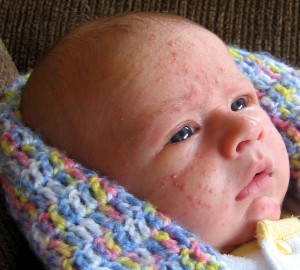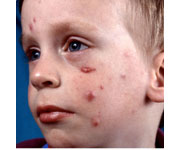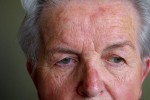The most common age to develop the first signs of acne – often greasy skin and blackheads – is early puberty. This is because the grease glands up to this stage are immature and too small to produce a lot of grease. Think about a child’s smooth skin and how soft a baby’s cheeks are – the last thing you would find with younger children is greasiness.
So, for most, acne first appears around 11 years old or over. Girls are more likely to gets spots at a younger age because their puberty usually starts earlier than for boys. However, boys get more of the male hormones commonly responsible for increasing the grease output of the body, so they may be more likely to get worse acne than girls.
Fast Facts
- 51 percent of women aged 20-29 report still having acne.
- Only 40 percent of people with acne understand what causes it.
- Less than a third of participants in a study with definite acne had sought help from a doctor.
Acne can affect almost anyone, at any age. Luckily, for many teenagers the skin improves over time. Medical textbooks describe many varieties of acne, and some of these seem to affect certain age groups more than others.
Infantile acne
 As the name suggests, this type of acne affects newborns and infants up to two years of age. A newborn may have an acne eruption on the nose or cheeks. This is usually caused by a surge in maternal hormones that occurs as the baby is developing, and the outbreak typically clears in a matter of weeks, often without the need for any treatment.
As the name suggests, this type of acne affects newborns and infants up to two years of age. A newborn may have an acne eruption on the nose or cheeks. This is usually caused by a surge in maternal hormones that occurs as the baby is developing, and the outbreak typically clears in a matter of weeks, often without the need for any treatment.
Many midwives or health visitors will describe these small spots as ‘normal milk spots’. So, if these spots are fairly normal, when should a parent seek help?
If the spots have not cleared up on their own after four to six weeks then seek help from a doctor. There are a few treatments more commonly used on adult acne that can be recommended or prescribed and will often need to be used for a relatively short time. These will usually be products applied topically (on top of the skin).
However, it is wise to start any such topical treatments by gradually introducing them to the tender skin of a baby. Using a damp cotton pad, apply the lotion or cream to the affected area, followed a few minutes later with a moisturizer such as baby lotion. This will help to reduce any dryness and keep the skin hydrated.
If there is no improvement after a couple of months, then return to your doctor. Getting acne at this stage of life may require some further medical investigation if it doesn’t clear after usual treatments. Similarly, if acne first appears at around three to six months without any previous signs, consult a doctor for further advice.
Childhood acne (ages two to six)
 It is very rare for children of this age to develop acne, especially as the main cause of acne in newborns – the surge in maternal hormones passed on in the womb – will have disappeared. While the spots can be treated with usual acne treatments, the child will probably require a referral to a dermatologist if it fails to respond.
It is very rare for children of this age to develop acne, especially as the main cause of acne in newborns – the surge in maternal hormones passed on in the womb – will have disappeared. While the spots can be treated with usual acne treatments, the child will probably require a referral to a dermatologist if it fails to respond.
Any possible underlying causes, such as problems with the endocrine (hormone producing) system or a tumor, could then be investigated. There are theories that getting acne at this stage may be an indication of future acne that can be harder to treat and more severe in nature. Having the acne investigated and treated with stronger medicines at an earlier stage might help to avoid or reduce future problems.
Adolescent acne
 This is by far the most common age to start developing acne. As it is so common, it should be considered more normal to have acne than not. As with acne at any age, if it appears to be getting worse or failing to respond to any self-medications, seek help from a doctor, nurse or pharmacist.
This is by far the most common age to start developing acne. As it is so common, it should be considered more normal to have acne than not. As with acne at any age, if it appears to be getting worse or failing to respond to any self-medications, seek help from a doctor, nurse or pharmacist.
Adult acne
 There is undoubtedly a group of people whose skin fails to improve following the more typical adolescent phase. Others may find their skin was relatively spot-free as a teenager, but becomes progressively worse in their 20s and 30s.
There is undoubtedly a group of people whose skin fails to improve following the more typical adolescent phase. Others may find their skin was relatively spot-free as a teenager, but becomes progressively worse in their 20s and 30s.
For some, however, the first signs of acne do not appear until this age. This can often be more distressing than for those who have experienced ongoing teenage acne. Some people report how having acne for the first time in their late 20s was one of the hardest things they had to face, thinking they had somehow managed to have escaped the scourge of most teenagers.
Up to 51 percent of women have acne well into their 20s, but men are only just behind this figure. Some dermatologists estimate that 1 percent of men and 5 percent of women in their 40s are still affected by acne. The fact that there are more women than men in this age group may be a sign of an underlying condition known as polycystic ovary syndrome (PCOS).
This is fairly common, occurring in up to 5 percent of women. Some doctors believe that any woman who presents with acne in their 30s should be considered for investigation into this condition.
Where on the body does acne appear?
Acne occurs only where there are grease-producing glands (sebaceous glands). These are located on various parts of the body. The most commonly affected areas are:
- Face
- Neck
- Chest
- Back
- Shoulders
Some types of acne flare up on or around one area only, such as the scalp or buttocks. Other conditions linked to acne, but with different causes, can affect specific areas of the body where the skin folds, such as the groin, the armpits or under the breasts.
Although it is possible to get spots in other areas of the body, spots do not occur on the soles of the feet or the palms as these areas have no sebaceous glands.
Senile acne
 Although it may not be fair to consider anyone over 65 as ‘senile’, there is a type of acne that may appear in older people, taking the form of large blackheads. This will usually be painless and unlikely to cause any further problems, although doctors can treat these comedones with usual medication.
Although it may not be fair to consider anyone over 65 as ‘senile’, there is a type of acne that may appear in older people, taking the form of large blackheads. This will usually be painless and unlikely to cause any further problems, although doctors can treat these comedones with usual medication.
This may also be a time when rosacea first appears, which may be confused with acne. Where it differs from senile acne is that it doesn’t present with comedones.



